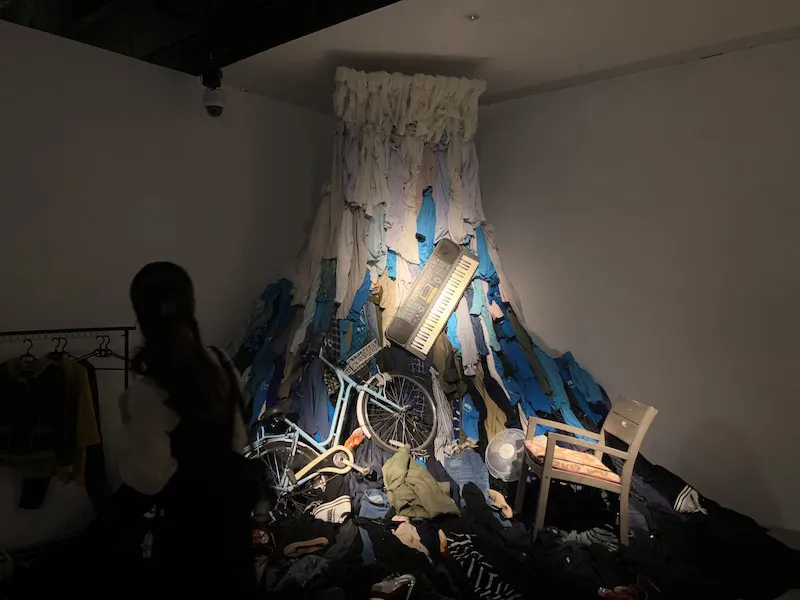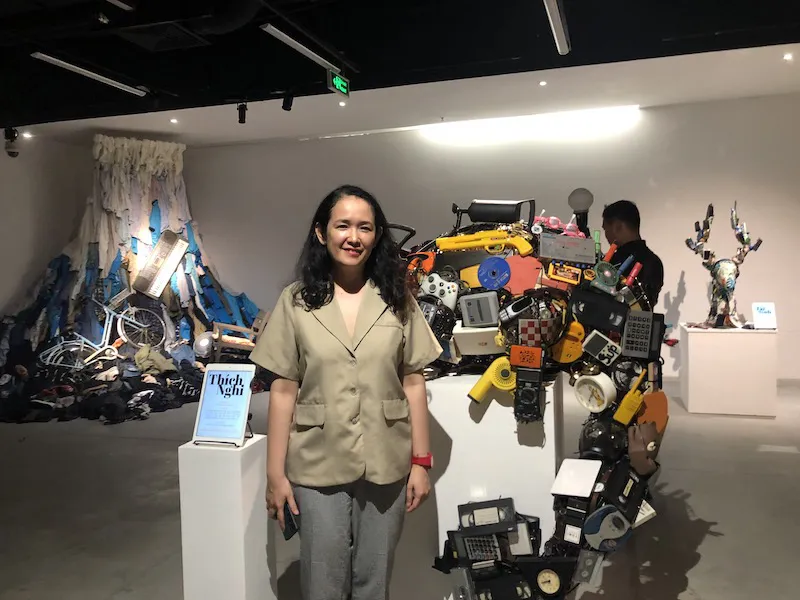[Efforts against pollution] 'Second Hand' art exhibition changes Hanoians' consumption habits
Reusing second-hand items is one of the practical actions promoting sustainable production and consumption, moving towards the transition to a circular economy in Vietnam.
Looking at the artwork titled Sweeping made from used clothes and household items, Hoa Mai, a 20-year-old university student in Hanoi, was embarrassed to realize that her excessive shopping habits would lead to waste and create a burden for the living environment.
| Artwork titled Sweeping at the exhibition. Photos: Nhat Khanh/The Hanoi Times |
"Sweeping" with the image of fierce waves delivered a warning message about the risk of waste to the environment today, stemming from excessive shopping habits among young people. Many of them quickly switch to new styles by buying new fashion clothes, leading to shortened product life cycles, consequently generating more waste.
“Sweeping” is one of the works created by artists from Hanoi and Ho Chi Minh at the exhibition “Living New with the Old” which is underway until June 19 in Hanoi. Artworks - made from used items sold on Cho Tot - reached local audiences such as Hoa Mai and Bui Minh Diep, 3rd-grade students from Hanoi’s Khuong Dinh primary school attending the opening ceremony on June 17.
“I was very surprised when the organizers presented works of art made from used items. This is a very significant exhibition and I understand better what a green lifestyle is, although I did when I heard parents and teachers talk a lot about reducing waste in the environment,” Diep told The Hanoi Times.
| The artwork titled Vun by artist Ly Quoc Co means if the useful life of an item increases, the production burden decreases. The materials that are used to make the work are household appliances, electronics, and old clothes, creating a couple embracing a bud. |
Vietnam is facing many serious challenges in terms of land resource depletion, pollution, environmental degradation and climate change. Therefore, it is necessary to seriously acknowledge that it is time for Vietnam to move towards sustainable development rather than economic growth as in recent years, according to Nguyen Dinh Tho, Director of the Institute of Strategy and Policy on Natural Resources and Environment (ISPONRE).
Selling an old item also means giving away the opportunity to find that item to someone in need, helping someone ease part of the financial burden. By actively buying and selling second-hand items, the young generation is contributing to building a sustainable future, because when the life cycle of a product increases, the production pressure on the environment is reduced.
Therefore, this is the reason why Cho Tot - the growing marketplace platforms in Southeast Asia, the United Nations Development Program (UNDP), the Institute of Strategy for Natural Resources & Environment Policy (ISPONRE) and the Circular Economy Network (CE Hub) organized the exhibition, he added.
“This exhibition wants to give viewers a new perspective on how we can make use of old things, prolong their use, or turn them into new tools, giving them a second life. This is an important principle and content of the circular economy,” Tho said.
| Hoang Thai Ly, lecturer of Interior and Exterior Design Faculty, the Hanoi University of Industrial Fine Arts |
From the perspective of a creator for the exhibition, Hoang Thai Ly, a professor at the Faculty of Interior and Exterior Design at Hanoi University of Industrial Fine Arts, shared that large cities such as Hanoi and Ho Chi Minh City are witnessing overconsumption.
"To realize the idea of this project: to stimulate the use of second-hand items, it took us a long time to understand what the meaning and message of the exhibition is and the value we bring to the community," she told The Hanoi Times.
Building circular economy in Vietnam
| Hoang Thanh Vinh from the UNDP and his children attend the exhibition in Hanoi. |
Hoang Thanh Vinh from the UNDP told The Hanoi Times that along with the small-scale exhibition, the organizers is planning a new initiative “Cho Tot for Circularity”, which calls for the cooperation of the community to create valuable products.
“This is one of the practical actions to promote sustainable production and consumption, towards the transition to a circular economy in Vietnam," he added.
According to Carousell Recommerce Index 2021, about 83% of Vietnamese people purchased used goods last year and planned to continue to buy second-hand items.
Besides, sustainable consumption, in which reuse, recycling and environmental protection is becoming one of the top concerns of young people, especially Gen Z - the generation leading the consumption trends in the near future. In 2021, the three most frequently traded categories on Cho Tot were electronics, home appliances and fashion.













